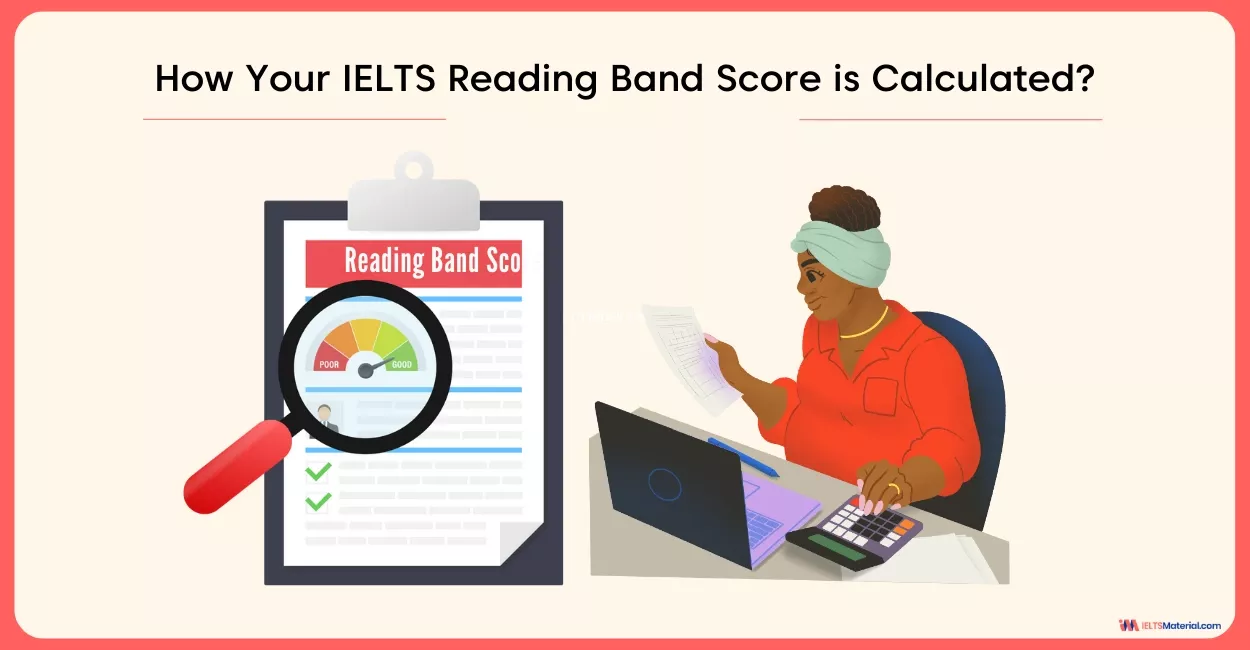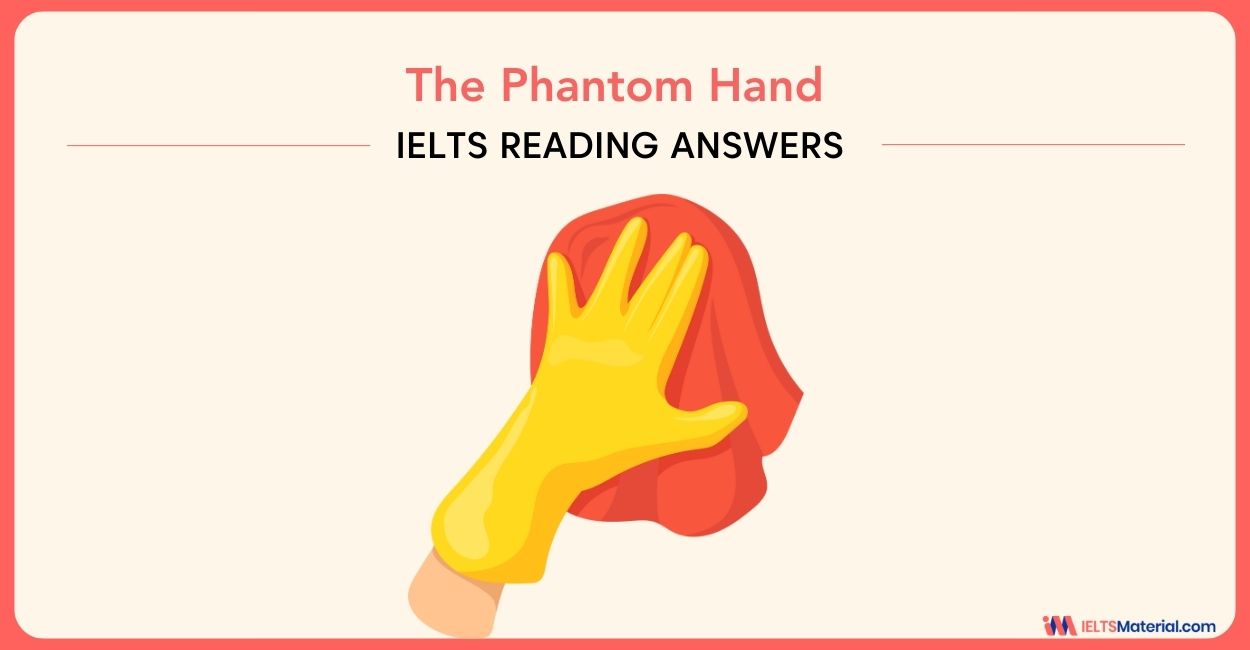The Phantom Hand – Reading Answers for IELTS Academic
13 min read
Updated On
-
Copy link
Table of Contents

Limited-Time Offer : Access a FREE 10-Day IELTS Study Plan!
IELTS Academic Reading has 40 questions in total, which are divided into three passages and one of these three passages is the Reading Answers of The Phantom Hand. Some candidates find it difficult to complete within 60 minutes. Therefore, you should begin practising IELTS Reading passages like The Phantom Hand regularly to master this section.
The Academic passage, The Phantom Hand, is a reading passage that appeared in an IELTS Test. Since questions get repeated in the IELTS exam, these passages are ideal for practice. If you want more practice, try taking an IELTS reading practice test.
The passage, The Phantom Hand, is an IELTS Academic reading passage that consists of 13 questions.
The question types found in the IELTS Reading Answers of The Phantom Hand are:
- Matching Features (Q. 1-4)
- Multiple-Choice Question (Q. 5-7)
- Summary Completion (Q. 8-13)
Want to discuss your IELTS queries with the best experts for FREE?
All you have to do is book your session now!
Reading Passage
The Phantom Hand
This illusion is extraordinarily compelling the first time you encounter it.
A There is a very striking illusion in which you can feel a rubber hand being touched as if it were your own. To find out for yourself, ask a friend to sit across from you at a small table. Set up a vertical partition on the table, rest your right hand behind it where you cannot see it, and place a plastic right hand in view. Ask your assistant to repeatedly tap and stroke your concealed right hand in a random sequence. Tap, tap, tap, stroke, tap, stroke, stroke. At the same time, while you watch, they must also tap and stroke the visible plastic dummy at exactly the same time in the same way. If your friend continues the procedure for about twenty or thirty seconds, something quite strange will happen: you will have an uncanny feeling that you are actually being stroked on the fake hand. The sensations you feel will seem to emerge directly from the plastic.
B Why does this happen? Matthew Botvinick and Jonathan Cohen, at the University of Pittsburgh and Carnegie Mellon University, who reported the so-called rubber-hand illusion in 1998, have suggested that the similarity in appearance makes the brain mistake the false hand for your real hand. They believe this illusion is strong enough to overcome the discrepancy between the position of your real hand that you can feel and the site of the plastic hand you can see.
C But that is not the whole story. William Hirstein and Kathleen Carrie Armel of the University of California discovered a further twist: the object your helper touches does not even need to resemble your hand. The same effect is produced if they tap and strike the table. Try the same experiment, but this time get your acquaintance to rub and tap the surface in front of you while making matching movements on your real, concealed hand. You will eventually start feeling touch sensations emerge from the wood surface.
D This illusion is extraordinarily compelling the first time you encounter it. But how can scientists be certain that the subject really believes that they are feeling sensations through the table? Kathleen Carrie Armel again and Vilayanur S Ramachandran learned that, once the illusion has developed, if you ‘threaten’ the table by aiming a blow at it, the person winces and even starts sweating. This reaction was demonstrated objectively by measuring a sudden decrease in electrical skin resistance caused by perspiration. It is as if the table becomes incorporated into a person’s own body image so that it is linked to emotional centers in the brain; the subject perceives a threat to the table as a threat to themselves.
E This may all sound like a magic trick, but it does have practical applications. In fact, the experiments were inspired by work with patients who had phantom limbs. After a person loses an arm from injury, they may continue to sense its presence vividly. Often, the Phantom seems to be frozen in a painfully awkward position. To overcome this, a patient was asked to imagine putting their phantom arm behind a mirror. By then putting their intact arm on the reflective side, they created the visual illusion of having restored the missing arm. If the patient now moved the intact arm, its reflection – and thus the phantom – was seen to move. Remarkably, it was felt to move as well, sometimes relieving the painful cramp.
F Beyond a practical application, these illusions also demonstrate some important principles underlying perception. Firstly, perception is based largely on matching up sensory inputs. As you feel your hand being tapped and stroked and see the table or dummy hand being touched in the same way, your brain asks itself, ‘What is the likelihood that what I see and what l feel could be identical simply by chance’? Nil. Therefore, the other person must be touching me.’ Secondly, this mechanism seems to be based on automatic processes that our intellect cannot override. The brain makes these judgments about the senses automatically; they do not involve conscious thought. Even a lifetime of experience that an inanimate object is not part of your body is abandoned in light of the perception that it is.
G All of us go through life making certain assumptions about our existence. ‘My name has always been Joe,’ someone might think. ‘l was born in San Diego,’ and so on. All such beliefs can be called into question at one time or another for various reasons. One premise that seems to be beyond question is that you are anchored in your body. Yet given a few seconds of the right kind of stimulation, even this obvious fact is temporarily forsaken, as a table or a plastic hand seem to become part of you.
Check Out – IELTS Reading Recent Actual Tests 2023
Questions 1-4
The text reports the findings of three teams of researchers.
Match statements 1- 4 with the correct team A, B or C.
A Botvinick and Cohen
B Hirstein and Armel
C Armel and Ramachandran
1 The illusion does not depend on the ‘phantom’ looking like a real hand.
2 The brain can disregard the spatial information.
3 If the fake hand is threatened, the subject will show signs of fear.
4 A hand-shaped object is required for the illusion.
Questions 5-7
5 How do researchers explain the fact that subjects respond physically when someone threatens to hit the table in front of them?
A The table becomes an integral part of the image subjects have of themselves.
B It is a reflex action triggered by the movement of the other person’s hand.
C An electrical connection is established between the subject and the table.
D Over time, the subject comes to believe that the table is one of his possessions.
6 What does the phantom hand experiment show us about the nature of human perception?
A It is based on conscious thought processes.
B It is primarily an unconscious process.
C It is closely related to intellectual ability.
D It relies only on sensory information.
7 Which of these statements best summarizes the wider implications of the experiments described in the text?
A The experiments are valuable in treating patients who have lost limbs.
B The experiments cast doubt on a fundamental human assumption.
C The experiments show humans to be less intelligent than was once thought.
D Human beings arrive at the truth by analyzing the evidence of their senses.
Questions 8-13
Complete the summary below.
Choose ONE WORD FROM THE TEXT AND/OR A NUMBER for each answer.
It is a recognized phenomenon that patients who have been injured and lost 8 …………………… sometimes continue to have feelings, like pain or 9……………………, in these parts of their body. In order to assist patients like this, doctors can use a 10 …………………… placed vertically on a flat surface. The patient imagines that he is putting his phantom arm behind the mirror and his 11 …………………… arm in front. When the patient moves the latter, the 12 …………………… also moves, giving the patient the illusion that his non-existent arm is moving. In some cases, this illusory movement may succeed in 13 …………………… the patient’s discomfort.
Looking for the key to IELTS Reading success?
Discover “The Ultimate Guide to IELTS Academic Reading” – your exclusive path to triumph!
Answers of The Phantom Hand Reading Answers with Location and Explanation
Check out The Phantom Hand Reading Passage with answers and detailed explanations.
1 Answer: B
Question type: Matching Features
Answer location: Paragraph C, Line 2- Line 3
Answer explanation: In the third paragraph, it is given “William Hirstein and Kathleen Carrie Armel of the University of California discovered a further twist: the object your helper touches does not even need to resemble your hand. The same effect is produced if they tap and strike the table.”. It is noted that Hirstein and Armel opine that the illusion need not look like (resemble) a hand and can be created by tapping and striking the table. Hence, the answer is B (Hirstein and Armel).
2 Answer: A
Question type: Matching Features
Answer location: Paragraph B, Line 2 – Line 3
Answer explanation: In the specified lines, it is stated that “Matthew Botvinick and Jonathan Cohen, at the University of Pittsburgh and Carnegie Mellon University, who reported the so-called rubber-hand illusion in 1998…the brain into mistaking the false hand for your real hand. They believe this illusion is strong enough to overcome the discrepancy between the position of your real hand that you can feel and the site of the plastic hand you can see.”. This shows that Botvinick and Cohen explain how the illusion created by the phantom hand makes the brain mistake the rubber hand for real, and there is a mismatch between their actual positions and the one they seem to be. Hence, the answer is A (Botvinick and Cohen).
3 Answer: C
Question type: Matching Features
Answer location: Paragraph D, Line 3
Answer explanation: In the mentioned paragraph, it is given that “Kathleen Carrie Armel again and Vilayanur S Ramachandran learned that, once the illusion has developed, if you ‘threaten’ the table by aiming a blow at it, the person winces and even starts sweating.”. It can be concluded that the fourth paragraph refers to the fact that if the fake hand or the illusion is threatened, the person or the subject will wince and start sweating (show signs of fear). Hence, the answer is C (Armel and Ramachandran).
4 Answer: A
Question type: Matching Features
Answer location: Paragraph B, Line 2
Answer explanation: In the second paragraph, it is given, “Matthew Botvinick and Jonathan Cohen, at the University of Pittsburgh and Carnegie Mellon University, who reported the so-called rubber-hand illusion in 1998, have suggested that the similarity in appearance feels the brain into mistaking the false hand for your real hand.”. This statement explores that Botvinick and Cohen tried their ‘rubber-hand’ experiment. Moreover, the word ‘similarity’ helps us to figure out that the object required for this illusion should be similar to a hand. Hence, the answer is A (Botvinick and Cohen).
5 Answer: A
Question type: Multiple-Choice Question
Answer location: Paragraph D, Line 3 – Line 5
Answer explanation: In the above-mentioned paragraph, it is stated that “Kathleen Carrie Armel again and Vilayanur S Ramachandran learned that, once the illusion has developed, if you ‘threaten’ the table by aiming a blow at it, the person winces and even starts sweating…as if the table becomes incorporated into a person’s own body image so that it is linked to emotional centers in the brain; the subject perceives a threat to the table as a threat to themselves.”. It can be pointed out that researchers like Armel and Ramachandran claim that the subject/person will react as the table is hit because it becomes an important (integral) part of their own body image. Hence, the answer is A (The table becomes an integral part of the image subjects have of themselves.).
6 Answer: B
Question type: Multiple-Choice Question
Answer location: Paragraph F, Line 6
Answer explanation: Through a reference line like, “The brain makes these judgments about the senses automatically; they do not involve conscious thought.”, it can be concluded that one of the important conclusions drawn from this phantom hand experiment is that the nature of human perception is primarily an unconscious process (do not involve conscious thought). Hence, the answer is B (It is primarily an unconscious process.).
7 Answer: B
Question type: Multiple-Choice Question
Answer location: Paragraph G, Line 6
Answer explanation: In the cited location, it is stated that “Yet given a few seconds of the right kind of stimulation, even this obvious fact is temporarily forsaken, as a table or a plastic hand seem to become part of you.”. Based on this reference, it can be concluded that the phantom hand experiment led people to believe that with the right kind of stimulus, a doubt on human assumption is created as the table or plastic hand becomes part of our body. Hence, the answer is B (The experiments cast doubt on a fundamental human assumption.).
8 Answer: limbs
Question type: Summary Completion
Answer location: Paragraph F, Line 2 – Line 3
Answer explanation: In the provided lines, it is said that “In fact, the experiments were inspired by work with patients who had phantom limbs. After a person loses an arm from injury…”. This shows that people who have been in accidents and lost a limb or arm are the preferred subjects for the experiment. Hence, the answer is ‘limbs’.
Unlock Explanations
If you want to have a look at the remaining explanations, sign up!
9 Answer: cramp
Question type: Summary Completion
Answer location: Paragraph E, Line 8
Answer explanation: In the specified line, it is stated that “Remarkably, it was felt to move as well, sometimes relieving the painful cramp.”. From this line, it can be inferred that people who have lost their arms can still feel pain and cramps and the experiments help them relieve it. Hence, the answer is ‘cramp’.
10 Answer: mirror
Question type: Summary Completion
Answer location: Paragraph E, Line 5
Answer explanation: In the corresponding line, it is mentioned that “To overcome this, a patient was asked to imagine putting their phantom arm behind a mirror.”. In other words, it can be said that to assist patients without limbs, doctors can use a mirror placed vertically on a flat surface and ask to imagine their phantom hand behind it. Hence, the answer is ‘mirror’.
11 Answer: intact
Question type: Summary Completion
Answer location: Paragraph E, Line 6
Answer explanation: In Paragraph E, it is stated that “By then putting their intact arm on the reflective side, they created the visual illusion of having restored the missing arm.”. This statement indicates that the patient imagines that he is putting his phantom arm behind the mirror and his intact arm in front. Hence, the answer is ‘intact’.
12 Answer: reflection
Question type: Summary Completion
Answer location: Paragraph E, Line 7
Answer explanation: The given line specifies that “If the patient now moved the intact arm, its reflection – and thus the phantom – was seen to move.”. It is indicated that when the patient moves the intact arm, the reflection of the phantom hand also moves, giving the patient the illusion that his non-existent arm is moving. Hence, the answer is ‘reflection’.
13 Answer: relieving
Question type: Summary Completion
Answer location: Paragraph E, Line 8
Answer explanation: In the paragraph, it is given, “Remarkably, it was felt to move as well, sometimes relieving the painful cramp.”. This reference proves that this experiment with the phantom hand gives an illusion and helps the person get relief from pain. Hence, the answer is ‘relieving’.
Tips for Answering the Question Types in The Phantom Hand IELTS Reading Answers
Since now you know the answers to the Reading Passage of The Phantom Hand with explanations, let us check out some quick tips to answer the types of questions in the The Phantom Hand IELTS Reading passage.
Matching Features:
In this type of question, you will have to match a list of options with the relevant set of statements. Some tips for answering matching features questions and obtain a high band in the IELTS examination are given below:
- Read questions and underline or circle keywords. This will help you find out where you would have to read and find later. Also, focus on how often every detail or name is appearing in the passage.
- Scan the passage and look for information given in the features and questions.
- Skim through the areas that are surrounded by keywords and features in the passage.
- Don’t get confused in case the text has synonyms of the information that is originally present in the question.
- Keep in mind that answers will not be in an order as questions.
Multiple-Choice Questions:
You will be given a reading passage followed by several questions based on the information in the paragraph in multiple-choice questions. Your task is to understand the question and compare it to the paragraph in order to select the best solution from the available possibilities.
- Before reading the passage, read the question and select the keywords. Check the keyword possibilities if the question statement is short on information.
- Then, using the keywords, read the passage to find the relevant information.
- To select the correct option, carefully read the relevant words and match them with each option.
- You will find several options with keywords that do not correspond to the information.
- Try opting for the elimination method mostly.
- Find the best option by matching the meaning rather than just the keywords.
Summary Completion:
Summary Completion is a type of IELTS reading question that requires you to fill in a gap in a paragraph with a word or phrase from the passage.
To answer summary completion questions, you can use the following strategies:
- Read the sentences attentively to get a sense of the type of word or phrase that is lacking.
- Scan the passage for the following keywords: The keywords in the text can assist you in identifying the appropriate word or phrase.
- Read the sentence that contains the missing word or phrase: This will assist you in understanding how the word or phrase fits into the sentence.
- Examine your response: After you’ve filled in the blanks, check sure your response makes sense in the context of the statement.
Also check:
- What Does the Consumer Think?- IELTS Reading Answers | IELTSMaterial.com
- Communicating in Colour, The Pursuit of Happiness, The Deep Sea Reading Answers
- Neuroaesthetics – IELTS Reading Answers
- The Phoenicians: An Almost Forgotten People Reading Answers
- Bilingualism in Children, Changing Rules for Health Treatment, The Romantic Poets Reading Answers
- The Grapes of Winter, Islands That Float, Ocean Plant life in decline – Reading Answers
Practice IELTS Reading based on question types

Start Preparing for IELTS: Get Your 10-Day Study Plan Today!
Recent Articles

Nehasri Ravishenbagam

Haniya Yashfeen

Haniya Yashfeen

Haniya Yashfeen




Post your Comments